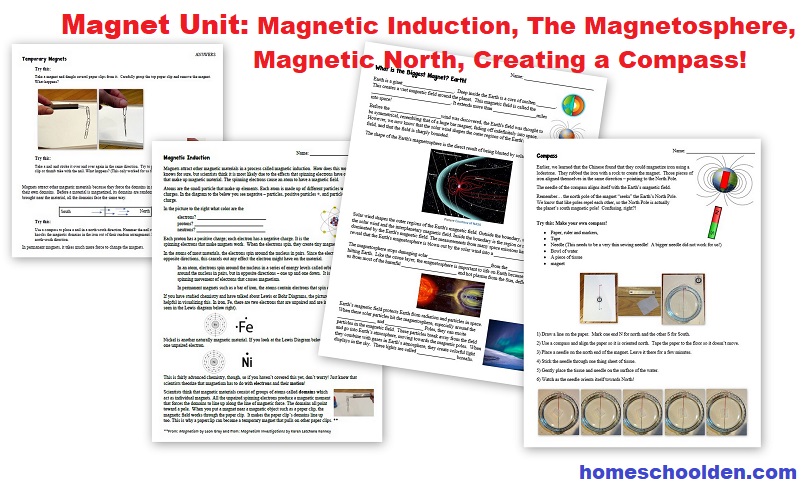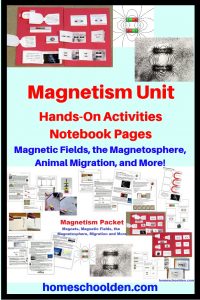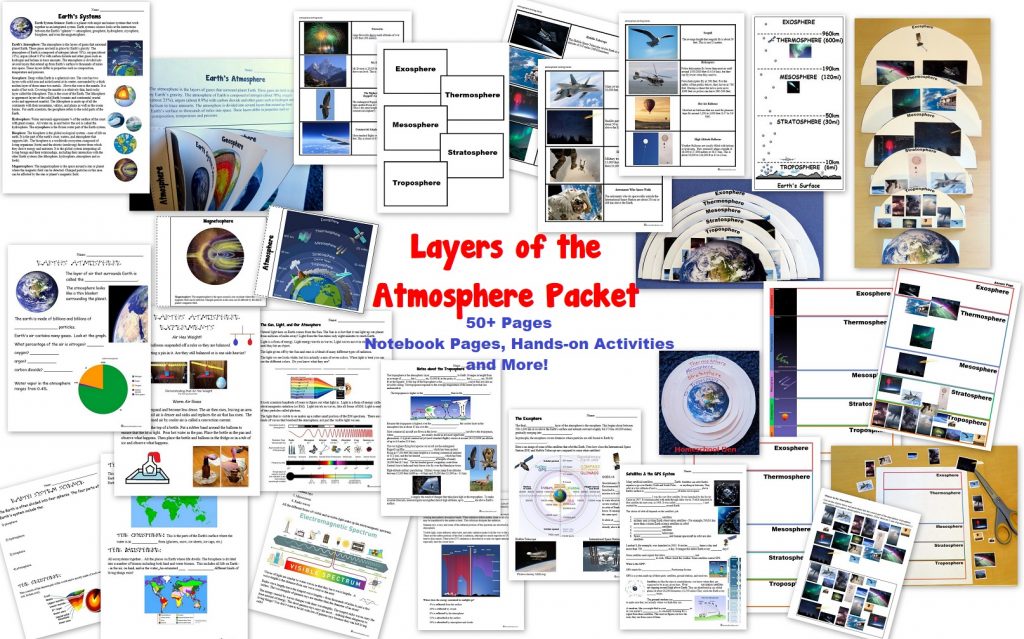Magnetism Unit on Magnetic Fields, the Magnetosphere, and Animal Migration
In our latest Magnetism Unit we did some really fun hands-on activities with magnets and magnetic fields! This 25+ page Magnet Packet includes notebook pages, worksheets, a half-dozen hands-on activity ideas, and an interactive notebook pieces about magnetism & the magnetosphere.
- how magnets were discovered,
- magnetic poles,
- magnetic attraction and repulsion,
- magnetic fields and the lines of magnetic force,
- magnetic induction & domains,
- Earth’s magnetic field – the magnetosphere,
- compasses, and
- finally animal’s ability to use Earth’s magnetic field in order to orient themselves and migrate thousands of miles.
This unit was especially fun because of all the experiments and hands-on activities the kids got involved in! Even my 15-year old was totally entranced by some of the activities we did together!
This unit was actually a detour unit! (Don’t you love when that happens?) We were starting to talk about Earth’s Atmosphere, but when we were reviewing Earth’s systems (the geosphere, hydrosphere, biosphere, and magnetosphere.) We decided to spend a bit of time on the Magnetosphere — Earth’s Magnetic Field. Then we jumped into the recent research about animal migration!
So now that you know how we happened on this unit, let me tell you more about what we covered!
Magnets:
We started with some of the history and legends about magnets. We reviewed the basics about magnets — that they have a north and south pole and that opposite poles attract and like poles repel.
Then they jumped right in to some simple activities about attraction and repulsion. There’s something just plain fun with magnets, right? The kids loved trying to make the hanging paper clip go as high as it could without falling! The kids were so involved with that (and it took so much time!) that was all we got to the first day!
Magnet Unit Supplies:
The next day was the really fun! Some of the items you need for this part of the unit (I’ll put in links to the ones we got, but you can use anything you have on hand). These are affiliate links.
- 2 Bar Magnets
- 1 horseshoe (or U) magnet
- Donut Magnet (sometimes called Magnet Rings) We had our own set of these, but this set has some fun activity cards that your kids might enjoy (see the picture above)!
- Iron Filings
- Boy scout compass
- Very thin sewing needle
Magnetic Fields:
We talked about magnetic fields and then did a number of hands-on activities to explore the magnetic fields generated by magnets in various positions. The kids *loved* this! Again, you will find the Iron Filings here. Be really generous when you shake the filings… it makes the magnetic fields stand out more.
Magnetic Induction, the Magnetosphere, Making a Homemade Compass:
We went on to talk about magnetic induction & the movement of electrons. We talked about domains and how temporary domains give items temporary magnetic properties. Then we talked about the magnetosphere and Earth’s magnetic fields.
The kids each made their own floating compass. Remember that if you do this activity you need a very thin, light sewing needle. Larger needles will sink! 🙂
Earth’s Magnetic Field and Animal Migration:
The last part of our magnet unit was all about animal’s ability to detect the Earth’s magnetic field.
We learned about some of the experiments scientists have done to uncover how animals are able to detect the magnetic field. It ranges from animals actually having magnetite inside them, to various proteins that change in the presence of light and create magnetic cells. This is some cutting-edge science at the moment, so there’s no doubt that more will be uncovered in the coming years about how animals use magnetism to migrate thousands of miles!
Below I’ve pictured the notebook pages, but there is a full-text set provided as well if you just want to read through this material with your kids. 🙂
Magnets, Magnet Fields & the Magnetosphere Interactive Notebook Activity:
Our last activity was to create some interactive notebook pages that the kids added to their science notebook. Students can either glue the pieces onto paper (as we did below), directly into a notebook or they can create a lapbook with the materials provided.
We used this as our final wrap up and review, but it can be used to introduce students to the materials as well. Students can either cut out the suggested answers or they can write their own answers into the insides of the pieces. Some of the questions it covers include:
- What is magnetism?
- Give some examples of objects that are attracted to magnets.
- What are some of the everyday uses of magnets?
- The region around Earth dominated by the planet’s magnetic field is called the… magnetosphere
- What are the two ends of a magnet called?
- The second page is mostly about magnetic fields

Click here to save this for later on Pinterest:
What ages is this packet for? I would say this packet is suitable for 3rd – 7th grades or so (ages 8-13 or so) – of course younger kids will love doing all the hands-on activities, so it is adaptable for homeschool families. My girls are 10 and just turned 13. They both enjoyed this unit a lot. I also had my high school aged (15-year old) son review some of the material with us and as I said above, we all really enjoyed playing around with the magnets and iron filings! 🙂
Is any background needed? My kids have a pretty good understanding of atoms (electrons, protons and neutrons). It is not necessary, but there is some discussion of electron orbitals that you may have to gloss over. (We did a Chemistry Unit last spring and went into a lot of detail about the periodic table, Bohr and Lewis Diagrams, etc.) Also, let me share what we were doing just before we jumped into this our Magnet Unit:
Just so you know, earlier this semester, my daughter (age 10) did the Where I Live Activity Packet (My galaxy, solar system, planet, continent, country, state, town, and home!). Then we moved on to the Layers of the Atmosphere Packet. We had just finished the introductory activity (below) when I decided to take this detour and talk about the magnetosphere and magnetic fields in more depth.

Again, neither of those units are necessary to do before this one, but I wanted you to know what we were up to! 🙂 The Earth’s Systems activity (above) is in the Layers of the Atmosphere Packet not in the Magnet Packet below.
Magnetism Packet:
Magnets, Magnetic Fields, the Magnetosphere & Migration
The Magnetism Packet is 25+ pages. Quick Preview
FAQ: Do I have to pay with PayPal? No, you can choose the grey box (here’s a pic) that says “pay with a debit or credit card.”
When you click on the link below, it will bring up a box asking for your email. You will receive an email from SendOwl (the delivery service I use) with a link to download this pdf. You will then be able to download and save the file to your computer. If any updates are made in the future, you will be sent those updates (you’ll have the option to opt out if you don’t want future updates.)
A Note About Supplies: This packet does require that you have certain materials on hand to get the most out of it. See the suggested supply list above.
The
Our units are PDF downloads.
Have any questions? Here are answers to some FAQ. And of course, feel free to email me if you need help or have any questions or special requests! ~Liesl
$5.99
Don’t forget to check your PayPal email address for the download link!
The Magnetism Packet is included in both the Earth Science Bundle of 5

$4.50 Where I Live Packet –Where I Live Packet – Quick Preview If you are interested in the Where I Live Packet (below) or any of the other packets in Our Store you can place them into the cart.
$6.99 Layers of the Atmosphere Packet (See the Bundle option below) Quick Preview for the Atmosphere Packet
$9.99 Earth Science Unit (175+ pages) – Layers of the Earth, Latitude/Longitude, Plate Tectonics, Faults, Earthquakes, Volcanoes, 4 Types of Mountains plus dozens of hands-on activity ideas! Quick Preview or Visit Post for more details. Right click on the image to enlarge. See BUNDLE options below. View image 1, image 2, image 3, image 4, image 5, image 6, image 7, image 8, image 9, image 10, image 11, image 12, image 13
Don’t forget to check your PayPal email address for the download link!
$5.50 Electricity and Circuits STEM Unit Quick Preview
$7.99 Chemistry Packet Chemistry Packet: Periodic Table, Atoms & Atomic Structure, Valence Electrons, Bohr Diagrams, Electron Dot Diagrams, Covalent & Ionic Bonds Quick Preview
$6.99 World Facts Packet – Quick Preview for the World Facts Packet Do your kids know the 4 largest countries? Which countries have the most people? The longest river? the largest cities? the most well-known world landmarks? This packet covers basic world and U.S. facts. We often started out the semester with a review of this material. ?
The second part of the World Facts Packet covers geography land form terms from lakes, islands and peninsulas to the difference between bays, gulfs and sounds or between deltas & estuaries. It also includes a brief study of topographic maps.
Don’t forget to check your PayPal email address for the download link!
$25.00 Human Body BUNDLE OPTION 1: Human Body Systems, Skeletal System Packet, Digestive System, Circulatory System Unit, Muscular System Packet, Nervous System Packet, Endocrine System, Reproductive System Worksheets (Does not include the Study of Cells Unit.)
See more information about these Human Body Bundle (or these individual packets) here.
$29.99 Human Body BUNDLE OPTION 2: Human Body Systems, A Study of Cells Unit, Skeletal System Packet, Digestive System, Circulatory System Unit, Muscular System Packet, Nervous System Packet, Endocrine System, Reproductive System Worksheets (We often talked about cells as we started our Human Body Units… then went on to talk about human body cells, tissues, organs & systems… and then would move on to a different body system each year. Generally as homeschoolers, we covered just one or two major body systems each year before moving on to another science topic.)
Don’t forget to check your PayPal email address for the download link!
To find out more about our Privacy Policy, click here.
See you again soon here or over at our Homeschool Den Facebook Page! You might also want to check out some of our resources pages above (such as our Science, Language Arts, or History Units Resource Pages) which have links to dozens of posts. You might want to join our free Homeschool Den Chat Facebook group. Don’t forget to check out Our Store as well.
Again, you can click here to Subscribe to our Homeschool Den Newsletter!
Happy Homeschooling, everyone!! ~Liesl
Disclosure: Please note that some of the links in this post are affiliate links, and at no additional cost to you, I will earn a commission if you decide to make a purchase.










































































